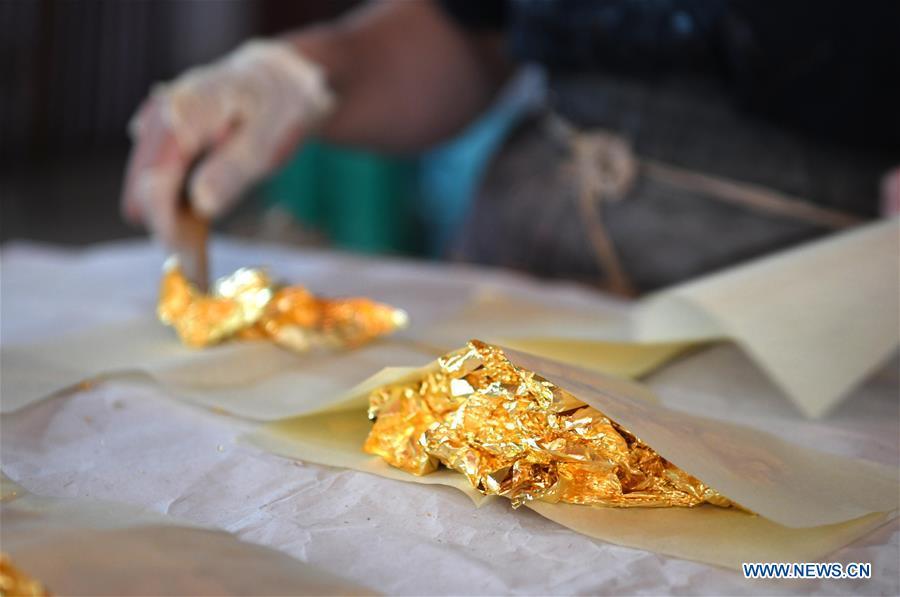
A worker prepares sheets of gold foil before grinding them into powder to make Fenlajian paper at a workshop run by paper artisan Liu Jing in Huanglu Township of Chaohu, east China's Anhui Province, May 23, 2019. Fenlajian is a high-end wax mineral paper which dates back to the Tang dynasty (618-907). For centuries, access to the Fenlajian paper had remained a privilege reserved solely for China's imperial families, due to the costly materials and the set of complicated procedures involved in its making. The techniques in producing this fine writing and painting material even became lost in the late Qing dynasty (1644-1911), until Liu Jing, an Anhui-based paper artisan, managed to revive them through constant trials by the end of the 20th century. Born in a family of paper-makers, Liu now runs a paper workshop dedicated to making Fenlajian and other classical papers while promoting their know-hows. Liu's classical paper processing techniques were listed as a national intangible cultural heritage in 2008, and he himself was named as a national representative inheritor to the aforementioned techniques in 2018. (Xinhua/Liu Junxi)
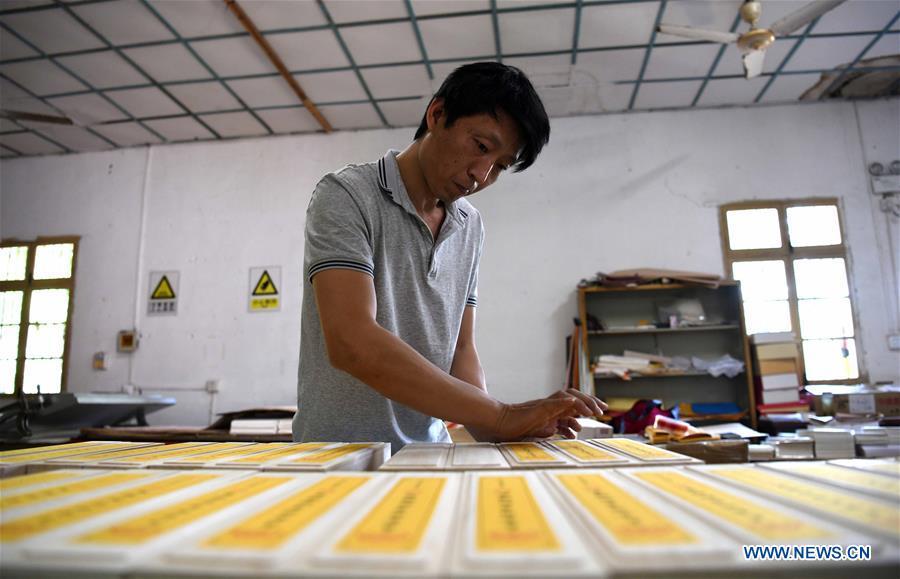
A worker wraps up Fenlajian paper products at a workshop run by paper artisan Liu Jing in Huanglu Township of Chaohu, east China's Anhui Province, May 23, 2019. Fenlajian is a high-end wax mineral paper which dates back to the Tang dynasty (618-907). For centuries, access to the Fenlajian paper had remained a privilege reserved solely for China's imperial families, due to the costly materials and the set of complicated procedures involved in its making. The techniques in producing this fine writing and painting material even became lost in the late Qing dynasty (1644-1911), until Liu Jing, an Anhui-based paper artisan, managed to revive them through constant trials by the end of the 20th century. Born in a family of paper-makers, Liu now runs a paper workshop dedicated to making Fenlajian and other classical papers while promoting their know-hows. Liu's classical paper processing techniques were listed as a national intangible cultural heritage in 2008, and he himself was named as a national representative inheritor to the aforementioned techniques in 2018. (Xinhua/Liu Junxi)
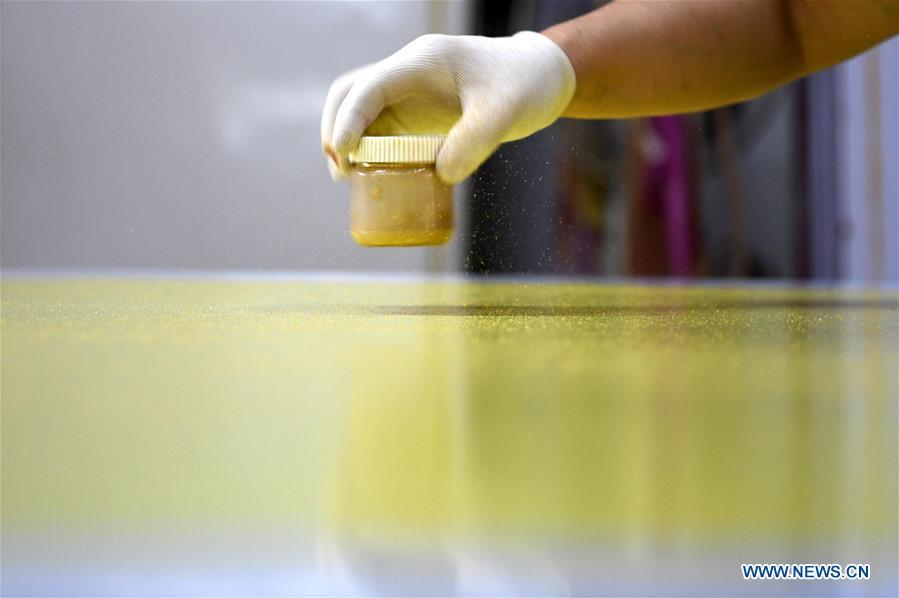
A worker scatters gold powder onto a piece of Fenlajian paper at a workshop run by paper artisan Liu Jing in Huanglu Township of Chaohu, east China's Anhui Province, May 23, 2019. Fenlajian is a high-end wax mineral paper which dates back to the Tang dynasty (618-907). For centuries, access to the Fenlajian paper had remained a privilege reserved solely for China's imperial families, due to the costly materials and the set of complicated procedures involved in its making. The techniques in producing this fine writing and painting material even became lost in the late Qing dynasty (1644-1911), until Liu Jing, an Anhui-based paper artisan, managed to revive them through constant trials by the end of the 20th century. Born in a family of paper-makers, Liu now runs a paper workshop dedicated to making Fenlajian and other classical papers while promoting their know-hows. Liu's classical paper processing techniques were listed as a national intangible cultural heritage in 2008, and he himself was named as a national representative inheritor to the aforementioned techniques in 2018. (Xinhua/Liu Junxi)
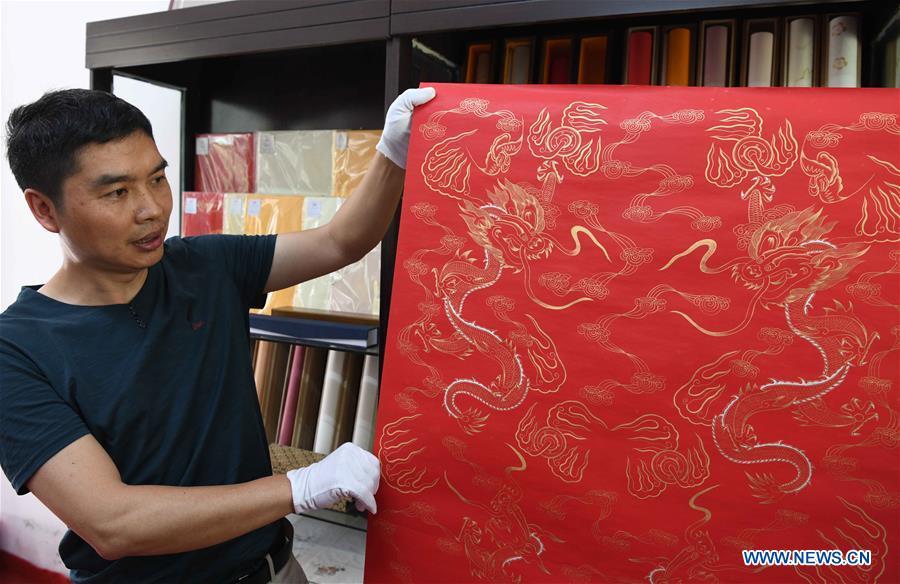
Paper artisan Liu Jing shows a piece of Fenlajian paper at his workshop in Huanglu Township of Chaohu, east China's Anhui Province, May 23, 2019. Fenlajian is a high-end wax mineral paper which dates back to the Tang dynasty (618-907). For centuries, access to the Fenlajian paper had remained a privilege reserved solely for China's imperial families, due to the costly materials and the set of complicated procedures involved in its making. The techniques in producing this fine writing and painting material even became lost in the late Qing dynasty (1644-1911), until Liu Jing, an Anhui-based paper artisan, managed to revive them through constant trials by the end of the 20th century. Born in a family of paper-makers, Liu now runs a paper workshop dedicated to making Fenlajian and other classical papers while promoting their know-hows. Liu's classical paper processing techniques were listed as a national intangible cultural heritage in 2008, and he himself was named as a national representative inheritor to the aforementioned techniques in 2018. (Xinhua/Liu Junxi)

A worker prepares sheets of gold foil before grinding them into powder to make Fenlajian paper at a workshop run by paper artisan Liu Jing in Huanglu Township of Chaohu, east China's Anhui Province, May 23, 2019. Fenlajian is a high-end wax mineral paper which dates back to the Tang dynasty (618-907). For centuries, access to the Fenlajian paper had remained a privilege reserved solely for China's imperial families, due to the costly materials and the set of complicated procedures involved in its making. The techniques in producing this fine writing and painting material even became lost in the late Qing dynasty (1644-1911), until Liu Jing, an Anhui-based paper artisan, managed to revive them through constant trials by the end of the 20th century. Born in a family of paper-makers, Liu now runs a paper workshop dedicated to making Fenlajian and other classical papers while promoting their know-hows. Liu's classical paper processing techniques were listed as a national intangible cultural heritage in 2008, and he himself was named as a national representative inheritor to the aforementioned techniques in 2018. (Xinhua/Liu Junxi)
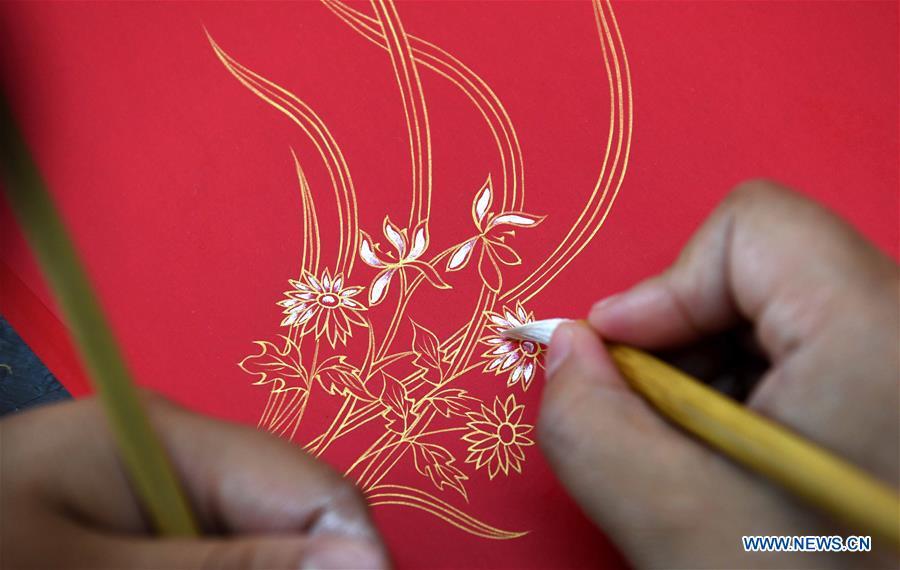
A worker applies gold paint to a piece of Fenlajian paper at a workshop run by paper artisan Liu Jing in Huanglu Township of Chaohu, east China's Anhui Province, May 23, 2019. Fenlajian is a high-end wax mineral paper which dates back to the Tang dynasty (618-907). For centuries, access to the Fenlajian paper had remained a privilege reserved solely for China's imperial families, due to the costly materials and the set of complicated procedures involved in its making. The techniques in producing this fine writing and painting material even became lost in the late Qing dynasty (1644-1911), until Liu Jing, an Anhui-based paper artisan, managed to revive them through constant trials by the end of the 20th century. Born in a family of paper-makers, Liu now runs a paper workshop dedicated to making Fenlajian and other classical papers while promoting their know-hows. Liu's classical paper processing techniques were listed as a national intangible cultural heritage in 2008, and he himself was named as a national representative inheritor to the aforementioned techniques in 2018. (Xinhua/Liu Junxi)
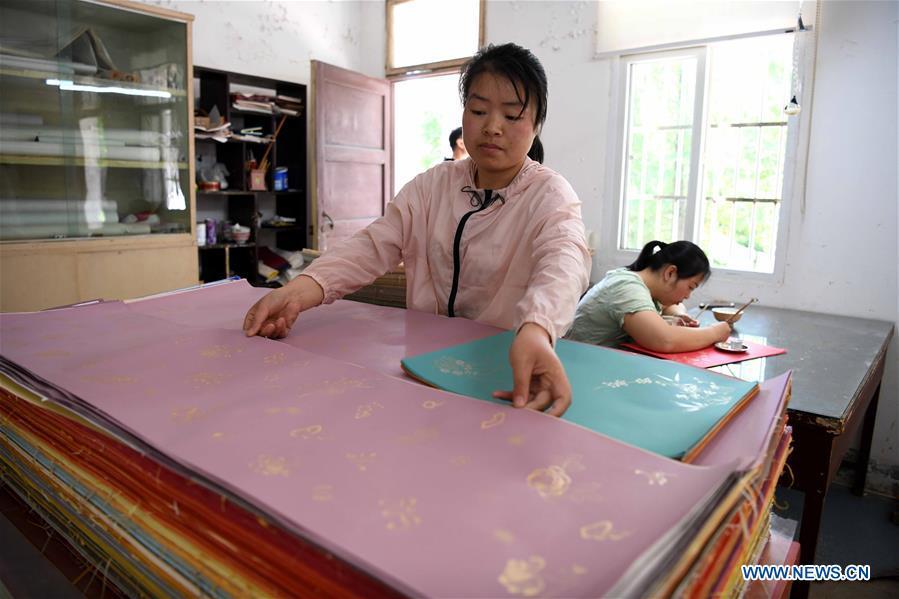
A worker examines half-finished Fenlajian paper at a workshop run by paper artisan Liu Jing in Huanglu Township of Chaohu, east China's Anhui Province, May 23, 2019. Fenlajian is a high-end wax mineral paper which dates back to the Tang dynasty (618-907). For centuries, access to the Fenlajian paper had remained a privilege reserved solely for China's imperial families, due to the costly materials and the set of complicated procedures involved in its making. The techniques in producing this fine writing and painting material even became lost in the late Qing dynasty (1644-1911), until Liu Jing, an Anhui-based paper artisan, managed to revive them through constant trials by the end of the 20th century. Born in a family of paper-makers, Liu now runs a paper workshop dedicated to making Fenlajian and other classical papers while promoting their know-hows. Liu's classical paper processing techniques were listed as a national intangible cultural heritage in 2008, and he himself was named as a national representative inheritor to the aforementioned techniques in 2018. (Xinhua/Liu Junxi)
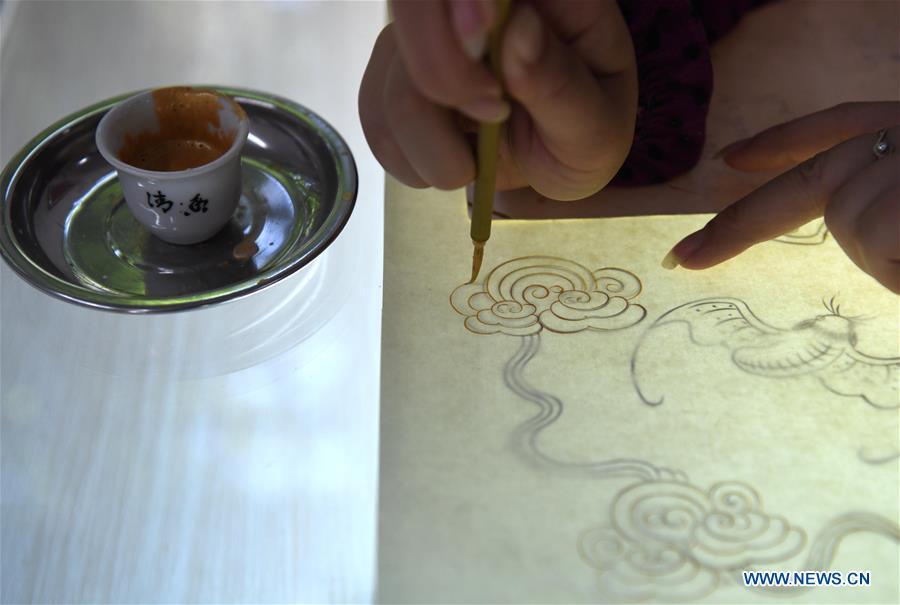
A worker applies gold paint to a piece of Fenlajian paper at a workshop run by paper artisan Liu Jing in Huanglu Township of Chaohu, east China's Anhui Province, May 23, 2019. Fenlajian is a high-end wax mineral paper which dates back to the Tang dynasty (618-907). For centuries, access to the Fenlajian paper had remained a privilege reserved solely for China's imperial families, due to the costly materials and the set of complicated procedures involved in its making. The techniques in producing this fine writing and painting material even became lost in the late Qing dynasty (1644-1911), until Liu Jing, an Anhui-based paper artisan, managed to revive them through constant trials by the end of the 20th century. Born in a family of paper-makers, Liu now runs a paper workshop dedicated to making Fenlajian and other classical papers while promoting their know-hows. Liu's classical paper processing techniques were listed as a national intangible cultural heritage in 2008, and he himself was named as a national representative inheritor to the aforementioned techniques in 2018. (Xinhua/Liu Junxi)
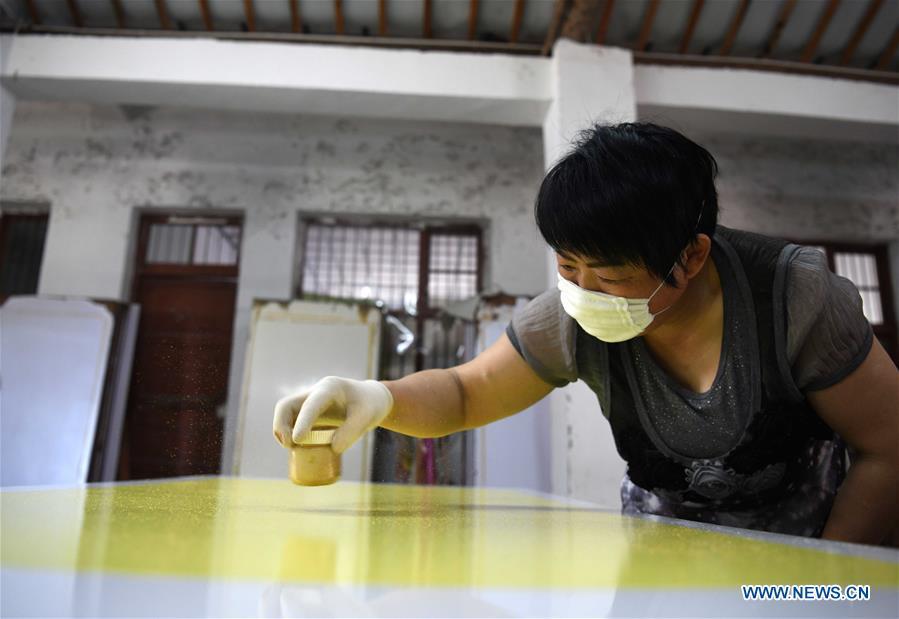
A worker scatters gold powder onto a piece of Fenlajian paper at a workshop run by paper artisan Liu Jing in Huanglu Township of Chaohu, east China's Anhui Province, May 23, 2019. Fenlajian is a high-end wax mineral paper which dates back to the Tang dynasty (618-907). For centuries, access to the Fenlajian paper had remained a privilege reserved solely for China's imperial families, due to the costly materials and the set of complicated procedures involved in its making. The techniques in producing this fine writing and painting material even became lost in the late Qing dynasty (1644-1911), until Liu Jing, an Anhui-based paper artisan, managed to revive them through constant trials by the end of the 20th century. Born in a family of paper-makers, Liu now runs a paper workshop dedicated to making Fenlajian and other classical papers while promoting their know-hows. Liu's classical paper processing techniques were listed as a national intangible cultural heritage in 2008, and he himself was named as a national representative inheritor to the aforementioned techniques in 2018. (Xinhua/Liu Junxi)























